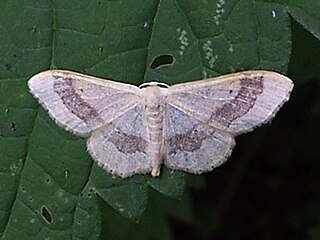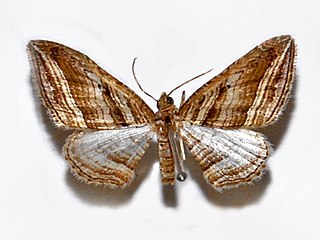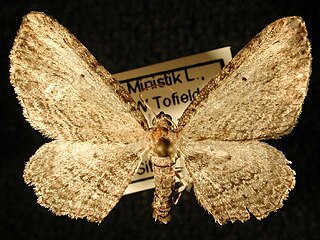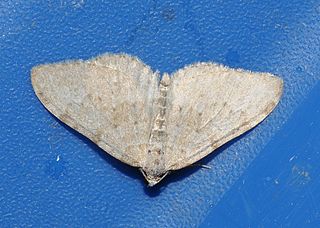
The willow beauty is a moth of the family Geometridae. It is a common species of Europe and adjacent regions. While it is found widely throughout Scandinavian countries, which have a maritime climate, it is absent from parts of the former USSR which are at the same latitude but have a more continental climate.

Idaea, sometimes called Hyriogona, is a large genus of geometer moths. It was erected by Georg Friedrich Treitschke in 1825. They are found nearly worldwide, with many native to the Mediterranean, the African savannas, and the deserts of western Asia.

Melitaea is a genus of brush-footed butterflies. They are here placed in the tribe Melitaeini of subfamily Nymphalinae; some authors elevate this tribe to subfamily rank.

Acompsia is a genus of the twirler moth family (Gelechiidae). Though it has once been assigned to the proposed subfamily "Anacampsinae", it is generally placed in the Dichomeridinae. Some authors include Telephila here as a subgenus, while others prefer to keep it distinct as its relationships are fairly obscure.
Ephysteris is a genus of the twirler moth family (Gelechiidae). Among these, it is assigned to tribe Gnorimoschemini of the subfamily Gelechiinae. Even though it is a rather diverse and widespread group, most of these small and inconspicuous moths were overlooked by scientists until the early 20th century. Almost 90 species are known today but new ones are still being discovered.

Lomographa bimaculata, the white-pinion spotted, is a species of geometer moth. It belongs to the large geometer moth subfamily Ennominae, and therein to the tribe Baptini. It is – under its junior synonym – the type species of its genus Lomographa. It is also the type species of Bapta, a junior objective synonym of Lomographa and the namesake of the Baptini. The species was first described by Johan Christian Fabricius ion 1775.

Scotopteryx is a genus of moths of the family Geometridae described by Jacob Hübner in 1825. It is suspected that some species currently placed here actually belong in Entephria.

Charissa is a genus of moths in the family Geometridae.

Drepanogynis is a genus in the geometer moth family (Geometridae). Long considered to hold about 5 dozen species, this number has been doubled after the last major revision. They are stout-bodied and hairy by geometer moth standards, usually have pale hindwings and rest with their wings angled upwards like a roof, as Nacophorini do. The genus is by and large restricted to Africa south of the Equator, with most species occurring in southern Africa.

Entephria is a genus in the geometer moth family (Geometridae). There is no unambiguous common name for these moths; like many other members of their subfamily Larentiinae, they are sometimes called "carpets". The genus was erected by Jacob Hübner in 1825.

Horisme is a genus of moths in the family Geometridae. The genus was described by Jacob Hübner in 1825.

Lomographa is a genus of moths in the family Geometridae. The genus was erected by Jacob Hübner in 1825.

Nebula is a genus of moths in the family Geometridae erected by Charles Théophile Bruand d'Uzelle in 1846.

Perizoma is a genus in the geometer moth family (Geometridae). It is the type genus of tribe Perizomini in subfamily Larentiinae. The tribe is considered monotypic by those who include the genera Gagitodes, Martania and Mesotype in Perizoma. Some other less closely related species formerly placed here are now elsewhere in the Larentiinae, e.g. in Entephria of the tribe Larentiini.

Depressaria is a genus of moths in the superfamily Gelechioidea. It is the type genus of subfamily Depressariinae, which is often – particularly in older treatments – considered a distinct family Depressariidae or included in the Elachistidae, but actually seems to belong in the Oecophoridae.

Pseudatemelia is a genus of gelechioid moths.

Agonopterix is a moth genus of the superfamily Gelechioidea. It is placed in the family Depressariidae, which was often – particularly in older treatments – considered a subfamily of the Oecophoridae or included in the Elachistidae.
Gnophini is a tribe of moths.















